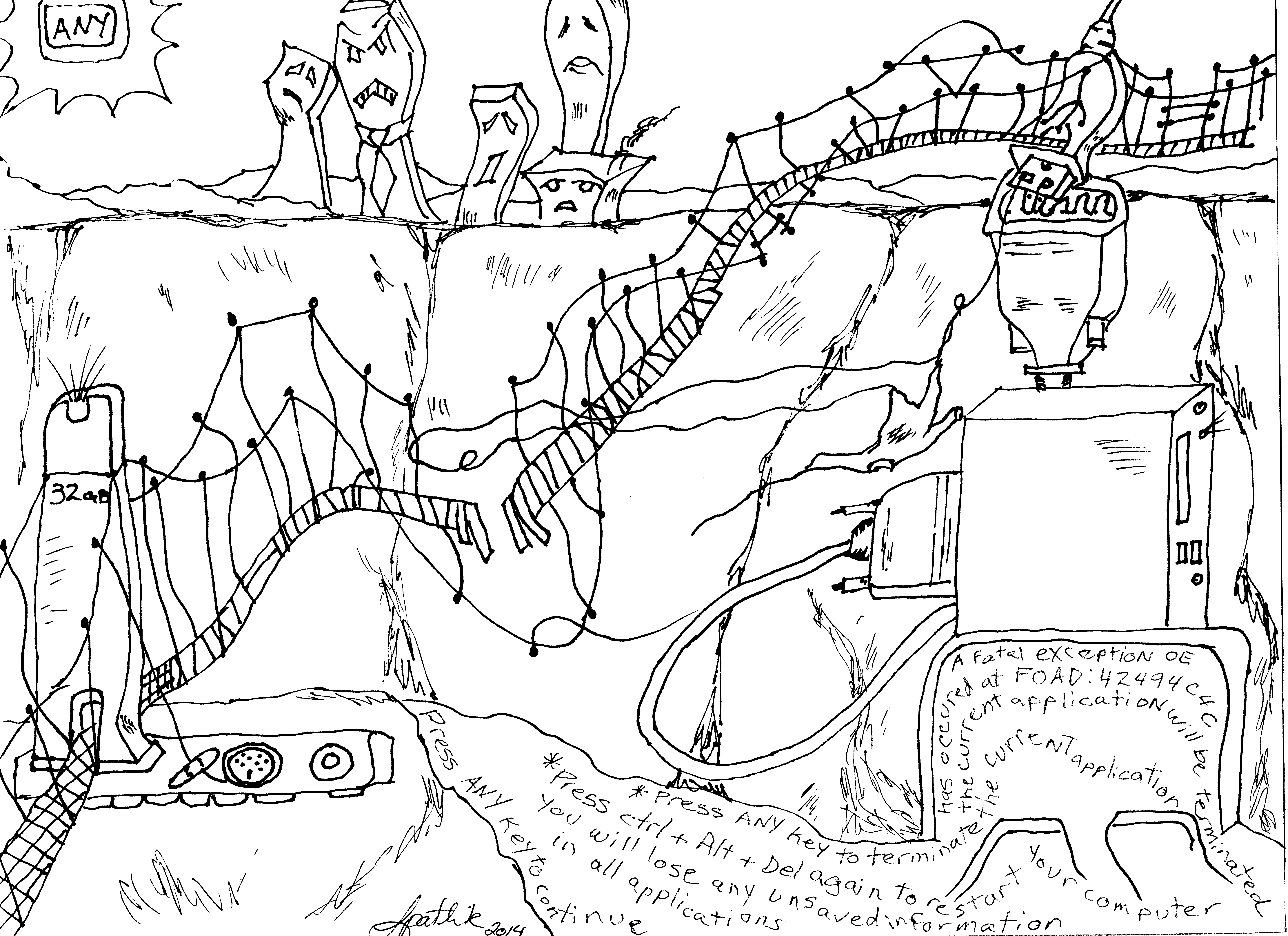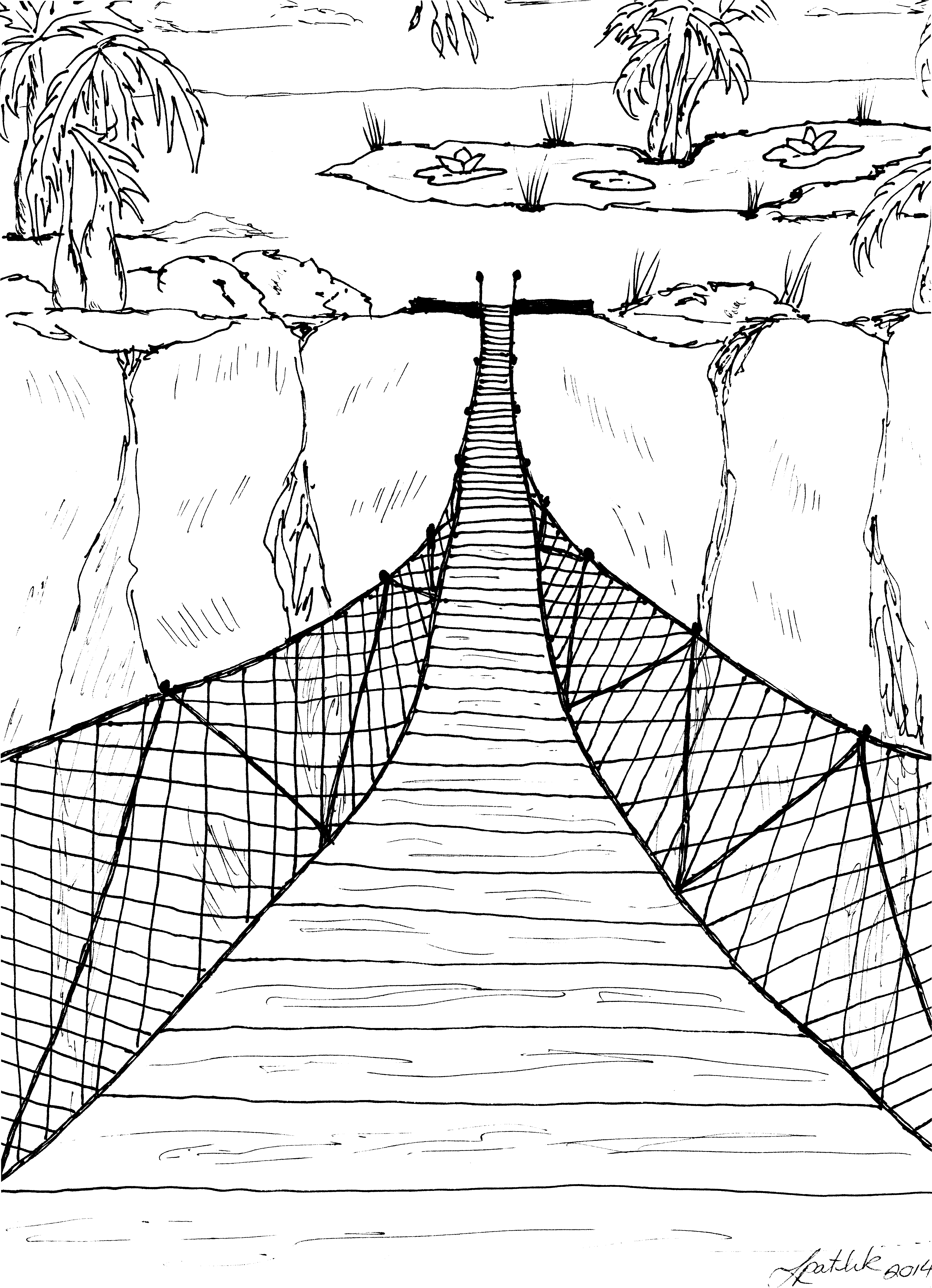A tale of two bridges
I was looking forward to opening the email and seeing the drawings.
They were line drawings, comic style. Here is the first drawing:

You can see Dave’s sweater slowly unravelling and being used to hold the whole shakey structure together.
The deck of the bridge represents the software platform, or rather, platforms, as each section of the bridge seems to have a different design.
The monitor is displaying an error message, which bleeds into the ravine (the ANY key is a tongue-in-cheek reference, which is placed high in the sky so as to be an unattainable solution);
The city represents frustrated, dismayed and angry users, on the edge of the ravine, all they want is a simple bridge to lead them across.
Why software invariably ends up looking like this bridge
Building great software is hard. Ironically, building mediocre software is probably harder. As with the bridge builders things are often made difficult for the engineers. They have many arbitary and unhelpful constraints from their own management, most of whom have forgotten why these rules were introduced in the first place and none of whom have ever used the tools that the engineers are using.
They are invariably dealing with many different systems, built with different technologies. Often these are proprietary systems which come without the actual source code. So, if a system does not quite work as it is supposed to they just have to work around it.
If they are lucky the system comes with support and there is someone at the end of a phone line who has never actually written any code, but who has a script to follow. And if you stick with them for the next 2.5 hours might get you to the point where they say, “Well we haven’t seen that error before”.
They file a bug and for the next two releases you eagerly install the new version only to find your bug hasn’t been fixed.
By the third release you have found a cunning way to actually take advantage of the bug to do some neat stuff you couldn’t do if the code actually worked as intended. So you build a whole new analysis system around that bug, only to discover they fixed it in the fourth release.
Every member of the team is an expert on one system or another, one language or another. It has taken them years to get to this level of comfort with their tool of choice. They remember the pain of getting there, they fear the day they have to switch to something new, go through all that pain again. They strongly believe that the tools they use are the very best (after the pain they have gone through to master it all, they had better be).
So is there a way to build software teams that actually works?
It turns out, there is. People have been doing it for decades now. It is called open source. Although, I think I prefer open literature.
But first, the tale continues.
The residents of the city were angry, but things got worse when the company they had paid to build the bridge went bust. Something to do with a lawsuit due to one of their previous projects and some people that died using it.
Someone called Richard had a workshop in which he built tools. Many people in the city thought he was a little crazy. He had a huge beard and didn’t get out much. But he built great tools. He also wrote instruction manuals telling you how to build those tools.
He would gladly give you the tools he built, but insisted on giving you a copy of his instruction manual too. He was delighted if you used it to build more tools and was also happy if you sold them or gave them to others. But he insisted that you also give them a copy of the instruction manual.
He loved it when you found new ways to build tools and updated your copy of the instruction manual. But, he insisted that if you gave anyone one of the tools you had built that you give them the full instruction manual telling them how to build the tool. So they could build new tools, just like Richard let you do.
Well along came Linus. He used to build wooden components. He used Richard’s tools and like Richard, gave away his components, along with the instruction manuals he had used to make them.
Beowulf came along and used Linus’s manual to teach himself how to link together these wooden components and make some really beautiful structures.
Larry started building tools that helped you do wonderful things with string. Larry’s tools let you take strings and weave them into ropes and baskets, nets and a whole wonderous world of things.
But, strings are delicate things and after a while threads would start to come unravelled. People who built stuff with Larry’s string tools also passed on their instruction manuals, but these manuals were really hard to read. Even the person who wrote them would struggle to follow the manual a year or so after it was written.
By now there were little cottage industries everywhere, writing tools to work with string. Guido came along and read the instruction books for all these tools and used these books to help him build his own string building tool.
His manual was easy to read and when you used it to build new tools to do things with strings the manuals for those tools were really easy to follow. Guido also introduced a thing he called the GIL. Nobody really understood this thing, but Guido insisted it was really important and would help stop threads unravelling.
Well by now, many of the people of the city were working with all these tools and doing some wonderful things.
Managing all these instruction manuals was becoming a bit of a challenge. There were thousands of manuals and each manual came in lots of versions.
Libraries sprung up to hold the manuals. The libraries all had strange names like sccs, rcs, cvs and svn. The neat thing was the libraries came with instruction manuals that helped you use them.
Linus grew frustrated with these libraries, as did others and they came up with a new type of library that made it easy for anyone to take a copy of the whole library and create a new library.
Linus created a library called git. Others created bazaar and mercurial. Life was good.
But, few people could understand how git worked. Some read the manual Linus had written and managed to figure it all out. They made changes to the manual, made it easier to read and created new types of git library that mere mortals could also use. And they taught each other how to use the library.
Well by now the people of the city were hard at work on the bridge. And bit by bit, using all these tools, they transformed it into this beautiful, simple structure:

Jacob came along on his pony and rode across the bridge to the beautiful oasis on the other side.